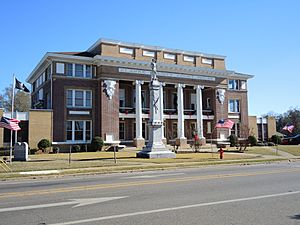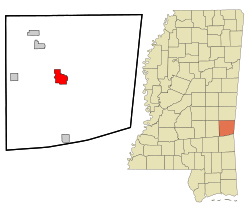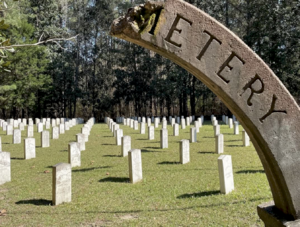Quitman, Mississippi facts for kids
Quick facts for kids
Quitman, Mississippi
|
|||
|---|---|---|---|

Clarke County Courthouse and Confederate monument in Quitman
|
|||
|
|||
| Motto(s):
"A Very Special Place To Call Home"
|
|||

Location of Quitman, Mississippi
|
|||
| Country | United States | ||
| State | Mississippi | ||
| County | Clarke | ||
| Area | |||
| • Total | 5.90 sq mi (15.29 km2) | ||
| • Land | 5.18 sq mi (13.41 km2) | ||
| • Water | 0.73 sq mi (1.88 km2) | ||
| Elevation | 230 ft (70 m) | ||
| Population
(2020)
|
|||
| • Total | 2,061 | ||
| • Density | 398.11/sq mi (153.71/km2) | ||
| Time zone | UTC-6 (Central (CST)) | ||
| • Summer (DST) | UTC-5 (CDT) | ||
| ZIP code |
39355
|
||
| Area code(s) | 601 | ||
| FIPS code | 28-60720 | ||
| GNIS feature ID | 0676438 | ||
Quitman is a city located in Clarke County, Mississippi, in the United States. It is the main city, also known as the county seat, of Clarke County. The city is built along the Chickasawhay River. In 2020, about 2,061 people lived in Quitman.
Contents
Exploring Quitman's Past: A Look at Its History
Quitman was officially started in 1839. It was chosen to be the county seat, which means it became the main center for government in Clarke County.
The Civil War and the Texas Hospital
During the American Civil War, a special hospital was built in Quitman. It was created to help Confederate soldiers from Texas. Money for the hospital came from cities like Galveston and Houston.
A surgeon named Enos Bonney later took charge of the hospital. Even though it helped soldiers from any state, people often called it "The Texas Hospital." Soldiers who were hurt in battles like the Second Battle of Corinth or suffered from diseases were treated there. A cemetery was also set up next to the hospital for those who died.
General Sherman's Actions in Quitman
Later in the war, General Sherman led a military campaign. During this time, a Union general named Walter Q. Gresham was sent to Quitman. His job was to destroy anything that could help the Confederacy.
His troops burned down important buildings in Quitman. This included the town jail, the courthouse, many stores, the railroad station, and even the Methodist Church, which was being used as a hospital. The entire Texas Hospital complex, with its main buildings and barracks, was also burned down and was never rebuilt.
How Quitman Got Its Name
The Mississippi Legislature officially recognized Quitman on February 13, 1839. The city was named after General John A. Quitman. He was an important politician in Mississippi and a veteran of the Mexican–American War. He was also a leader who strongly supported states' rights, including the right to own enslaved people.
Understanding Quitman's Location: Geography
Quitman is located near the center of Clarke County. Mississippi Highway 18 runs right through the middle of the city.
According to the United States Census Bureau, Quitman covers a total area of about 5.90 square miles (15.3 square kilometers). Most of this area, about 5.18 square miles (13.4 square kilometers), is land. The rest, about 0.73 square miles (1.9 square kilometers), is water.
What's the Weather Like in Quitman? Climate Information
| Climate data for Quitman | |||||||||||||
|---|---|---|---|---|---|---|---|---|---|---|---|---|---|
| Month | Jan | Feb | Mar | Apr | May | Jun | Jul | Aug | Sep | Oct | Nov | Dec | Year |
| Mean daily maximum °F (°C) | 56.6 (13.7) |
62.0 (16.7) |
69.2 (20.7) |
77.5 (25.3) |
83.9 (28.8) |
89.7 (32.1) |
91.9 (33.3) |
91.5 (33.1) |
87.0 (30.6) |
77.8 (25.4) |
68.6 (20.3) |
60.0 (15.6) |
76.3 (24.6) |
| Mean daily minimum °F (°C) | 32.9 (0.5) |
36.1 (2.3) |
42.6 (5.9) |
50.3 (10.2) |
58.2 (14.6) |
65.1 (18.4) |
68.5 (20.3) |
67.6 (19.8) |
62.3 (16.8) |
49.2 (9.6) |
41.6 (5.3) |
35.4 (1.9) |
50.8 (10.4) |
| Average precipitation inches (mm) | 5.5 (140) |
4.9 (120) |
6.1 (150) |
5.3 (130) |
4.0 (100) |
4.0 (100) |
5.1 (130) |
3.5 (89) |
3.8 (97) |
3.2 (81) |
4.0 (100) |
5.3 (130) |
54.8 (1,390) |
| Source: Weatherbase | |||||||||||||
Who Lives in Quitman? Demographics
| Historical population | |||
|---|---|---|---|
| Census | Pop. | %± | |
| 1880 | 410 | — | |
| 1890 | 395 | −3.7% | |
| 1900 | 498 | 26.1% | |
| 1910 | 950 | 90.8% | |
| 1920 | 1,375 | 44.7% | |
| 1930 | 1,872 | 36.1% | |
| 1940 | 1,471 | −21.4% | |
| 1950 | 1,817 | 23.5% | |
| 1960 | 2,030 | 11.7% | |
| 1970 | 2,702 | 33.1% | |
| 1980 | 2,632 | −2.6% | |
| 1990 | 2,736 | 4.0% | |
| 2000 | 2,463 | −10.0% | |
| 2010 | 2,323 | −5.7% | |
| 2020 | 2,061 | −11.3% | |
| U.S. Decennial Census | |||
| Race | Num. | Perc. |
|---|---|---|
| White | 1,189 | 57.69% |
| Black or African American | 759 | 36.83% |
| Native American | 9 | 0.44% |
| Asian | 4 | 0.19% |
| Pacific Islander | 2 | 0.01% |
| Other/Mixed | 72 | 3.49% |
| Hispanic or Latino | 28 | 1.36% |
In 2020, the United States census counted 2,061 people living in Quitman. These people lived in 897 households, and 619 of those were families.
Learning in Quitman: Education
The Quitman School District serves the city's students. For higher education, the county is part of the zone for Jones College.
Famous Faces from Quitman: Notable People
Many interesting people have come from Quitman, including:
- Andy Blakeney, a talented jazz trumpeter
- Wyatt Emory Cooper, a well-known writer
- Oscar W. Gillespie, who served as a U.S. Representative for Texas
- Dustin J. Lee, a Corporal in the United States Marine Corps
- Sam C. Massingale, an American politician and a U.S. Representative from Oklahoma
- Kelly McCarty, a former NBA basketball player
- Antonio McDyess, a former NBA power forward
- Tarvarius Moore, an NFL defensive back
- Homer Smith, Jr, a journalist
- Samuel H. Terral, who was a Justice on the Mississippi Supreme Court from 1897 to 1903
- James Yates (activist), a labor organizer, political activist, and veteran of the Spanish Civil War
See also
 In Spanish: Quitman (Misisipi) para niños
In Spanish: Quitman (Misisipi) para niños





